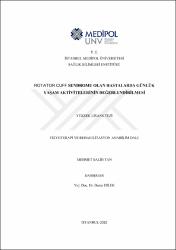| dc.contributor.advisor | Dilek, Burcu | |
| dc.contributor.author | Tan, Mehmet Salih | |
| dc.date.accessioned | 2021-05-26T13:02:11Z | |
| dc.date.available | 2021-05-26T13:02:11Z | |
| dc.date.issued | 2016 | en_US |
| dc.date.submitted | 2016-12-22 | |
| dc.identifier.citation | Tan, M. S. (2016). Rotator cuff sendromu olan hastalarda günlük yaşam aktivitelerinin değerlendirilmesi. (Yayınlanmamış yüksek lisans tezi). İstanbul Medipol Üniversitesi Sağlık Bilimleri Enstitüsü, İstanbul. | en_US |
| dc.identifier.uri | https://hdl.handle.net/20.500.12511/6939 | |
| dc.description.abstract | Çalışmanın amacı, rotator cuff sendromu tanısı alan hastalarda, ağrı, eklem hareket açıklığı ve kas kuvvetinin günlük yaşam aktiviteleri ile ilişkisini ortaya koymaktır. Bu çalışma 2016- 2017 tarihleri arasında İstanbul Medipol Mega Üniversite Hastanesi, Fizik Tedavi ve Rehabilitasyon Bölümü'nde gerçekleştirildi. Bölümümüze omuz ağrı problemleri ile başvuran, rotator cuff sendromu tanısı almış hastalar çalışmaya dâhil edildi. Çalışmaya katılmayı kabul eden 19-64 yaş aralığında yer alan 40 hasta çalışma kapsamında değerlendirildi. Çalışmaya katılan bireylerin yaş, cinsiyet, meslek, eğitim, boy, kilo, medeni durum, dominant taraf ve etkilenen taraf bilgileri kaydedildi.Ek olarak tanısal testlerden jobe testi, patte test, gerber lift-off testi, kol düşme testi, iç rotasyon yetmezlik belirtisi (lag sign), dış rotasyon yetmezlik belirtisi sonuçları da kayıt altına alındı. Olguların gece, istirahat, aktivite ve ağır cisim taşıma ağrı şiddeti Vizüel Anolog Skala ile, eklem hareket açıklığı universal gonyometre ile, kas kuvveti ölçümü manuel kas testi ile, üst taraf aktivite ve katılım düzeyi Quick-DASH (The Disabilities of the Arm, Shoulder and Hand) ile, günlük yaşam aktivitelerindeki bağımsızlığı fiziksel aktivite katılım düzeyleri Uluslararası Fiziksel Aktivite Anketi'nin kısa formu ile, yaşam kalitesine dair aktiviteleri ise SF-36 (Kısa Form-36) ile değerlendirildi. Çalışma sonucuna göre Rotator cuff sendromu olan olgularda omuz ağrıların da artış görüldüğü, bu durumun omuz eklem hareket açıklığını azalttığı ve kas kuvvetinde azalmaya neden olduğu tespit edildi. Azalan eklem hareket açıklığının yaşam kalitesini düşürdüğü ve fiziksel aktivitelere katılım düzeyleri üzerinde herhangi bir etki yapmadığı tespit edildi. Bununla birlikte, ağrının yaşam kalitesi düzeyinde azalmaya yol açtığı ve fiziksel aktivitelere katılım düzeyleri üzerinde herhangi bir etkiye sahip olmadığı görüldü. Yine, çalışmamız omuz kas kuvvetinin azalmasıyla yaşam kalitesinin düştüğünü gösterdi. | en_US |
| dc.description.abstract | The aim of the study is to reveal the relationship between pain, joint range of motion and muscle strength in daily living activities in patients with rotator cuff syndrome. This study was carried out between 2016 and 2017 at the Department of Physical Therapy and Rehabilitation at the Medipol Mega University Hospital in Istanbul. Patients with rotator cuff syndrome who were admitted with episodic shoulder pain problems were included in the study. Forty patients aged 19-64 who agreed to participate in the study were included in the study. Age, gender, occupation, education, height, weight, marital status, dominant side and affected side were recorded. However, the results of the diagnostic tests including the jobe test, patte test, gerber lift-off test, arm drop test, lag sign, and external rotation insufficiency were also recorded. Pain intensity at night, rest, activity, and heavy body movement were assessed by Visual Analog Scale, normal range of motion was assessed with universal goniometer, muscle strength was assessed with manual muscle test, upper activity and participation level with Quick-DASH (The Disabilities of the Arm, Shoulder and Hand), independence physical activity levels in Daily Life Activities The short form of the International Physical Activity Questionnaire and the quality of life activities were evaluated by the SF-36 (Short Form-36). In the study it was determined that the shoulder injuries caused the pain to increase, the shoulder joint range of motion to decrease and muscle strength to decrease. It was found that the decreased range of motion of the joint reduced the quality of life and it had no effect on the level of participation in physical activity. However, it was seen that the pain caused the decrease in the level of quality of life and did not have any effect on the level of participation in physical activities. Besides, our study showed that as the strength of the shoulder muscle decreased, the level of quality of life decreased. | en_US |
| dc.language.iso | tur | en_US |
| dc.publisher | İstanbul Medipol Üniversitesi Sağlık Bilimleri Enstitüsü | en_US |
| dc.rights | info:eu-repo/semantics/openAccess | en_US |
| dc.subject | Günlük Yaşam Aktiviteleri | en_US |
| dc.subject | Rotator Cuff Sendromu | en_US |
| dc.subject | Quick- DASH | en_US |
| dc.subject | SF-36 | en_US |
| dc.subject | UFAA | en_US |
| dc.subject | VAS | en_US |
| dc.subject | Yaşam Kalitesi | en_US |
| dc.subject | Daily Life Activities | en_US |
| dc.subject | IPAQ | en_US |
| dc.subject | Quality of Life | en_US |
| dc.subject | Quick-DASH | en_US |
| dc.subject | Rotator Cuff Syndrome | en_US |
| dc.subject | SF-36 | en_US |
| dc.subject | VAS | en_US |
| dc.title | Rotator cuff sendromu olan hastalarda günlük yaşam aktivitelerinin değerlendirilmesi | en_US |
| dc.title.alternative | Evaluation of daily life activities in patients with rotator cuff syndrome | en_US |
| dc.type | masterThesis | en_US |
| dc.department | İstanbul Medipol Üniversitesi, Sağlık Bilimleri Enstitüsü, Fizyoterapi ve Rehabilitasyon Ana Bilim Dalı | en_US |
| dc.relation.publicationcategory | Tez | en_US |


















